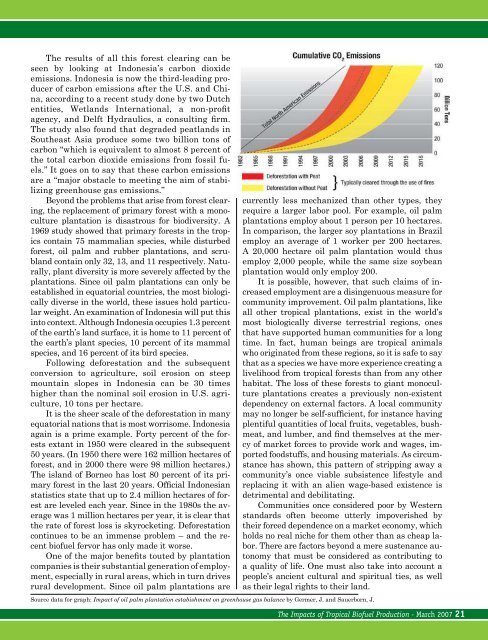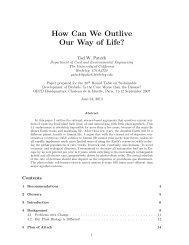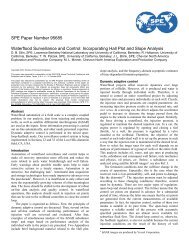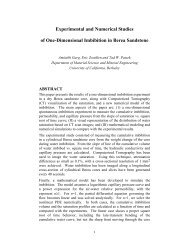The Disastrous Local and Global Impacts of Tropical Biofuel ...
The Disastrous Local and Global Impacts of Tropical Biofuel ...
The Disastrous Local and Global Impacts of Tropical Biofuel ...
You also want an ePaper? Increase the reach of your titles
YUMPU automatically turns print PDFs into web optimized ePapers that Google loves.
<strong>The</strong> results <strong>of</strong> all this forest clearing can beseen by looking at Indonesia’s carbon dioxideemissions. Indonesia is now the third-leading producer<strong>of</strong> carbon emissions after the U.S. <strong>and</strong> China,according to a recent study done by two Dutchentities, Wetl<strong>and</strong>s International, a non-pr<strong>of</strong>itagency, <strong>and</strong> Delft Hydraulics, a consulting firm.<strong>The</strong> study also found that degraded peatl<strong>and</strong>s inSoutheast Asia produce some two billion tons <strong>of</strong>carbon “which is equivalent to almost 8 percent <strong>of</strong>the total carbon dioxide emissions from fossil fuels.”It goes on to say that these carbon emissionsare a “major obstacle to meeting the aim <strong>of</strong> stabilizinggreenhouse gas emissions.”Beyond the problems that arise from forest clearing,the replacement <strong>of</strong> primary forest with a monocultureplantation is disastrous for biodiversity. A1969 study showed that primary forests in the tropicscontain 75 mammalian species, while disturbedforest, oil palm <strong>and</strong> rubber plantations, <strong>and</strong> scrubl<strong>and</strong>contain only 32, 13, <strong>and</strong> 11 respectively. Naturally,plant diversity is more severely affected by theplantations. Since oil palm plantations can only beestablished in equatorial countries, the most biologicallydiverse in the world, these issues hold particularweight. An examination <strong>of</strong> Indonesia will put thisinto context. Although Indonesia occupies 1.3 percent<strong>of</strong> the earth’s l<strong>and</strong> surface, it is home to 11 percent <strong>of</strong>the earth’s plant species, 10 percent <strong>of</strong> its mammalspecies, <strong>and</strong> 16 percent <strong>of</strong> its bird species.Following deforestation <strong>and</strong> the subsequentconversion to agriculture, soil erosion on steepmountain slopes in Indonesia can be 30 timeshigher than the nominal soil erosion in U.S. agriculture,10 tons per hectare.It is the sheer scale <strong>of</strong> the deforestation in manyequatorial nations that is most worrisome. Indonesiaagain is a prime example. Forty percent <strong>of</strong> the forestsextant in 1950 were cleared in the subsequent50 years. (In 1950 there were 162 million hectares <strong>of</strong>forest, <strong>and</strong> in 2000 there were 98 million hectares.)<strong>The</strong> isl<strong>and</strong> <strong>of</strong> Borneo has lost 80 percent <strong>of</strong> its primaryforest in the last 20 years. Official Indonesianstatistics state that up to 2.4 million hectares <strong>of</strong> forestare leveled each year. Since in the 1980s the averagewas 1 million hectares per year, it is clear thatthe rate <strong>of</strong> forest loss is skyrocketing. Deforestationcontinues to be an immense problem – <strong>and</strong> the recentbi<strong>of</strong>uel fervor has only made it worse.One <strong>of</strong> the major benefits touted by plantationcompanies is their substantial generation <strong>of</strong> employment,especially in rural areas, which in turn drivesrural development. Since oil palm plantations arecurrently less mechanized than other types, theyrequire a larger labor pool. For example, oil palmplantations employ about 1 person per 10 hectares.In comparison, the larger soy plantations in Brazilemploy an average <strong>of</strong> 1 worker per 200 hectares.A 20,000 hectare oil palm plantation would thusemploy 2,000 people, while the same size soybeanplantation would only employ 200.It is possible, however, that such claims <strong>of</strong> increasedemployment are a disingenuous measure forcommunity improvement. Oil palm plantations, likeall other tropical plantations, exist in the world’smost biologically diverse terrestrial regions, onesthat have supported human communities for a longtime. In fact, human beings are tropical animalswho originated from these regions, so it is safe to saythat as a species we have more experience creating alivelihood from tropical forests than from any otherhabitat. <strong>The</strong> loss <strong>of</strong> these forests to giant monocultureplantations creates a previously non-existentdependency on external factors. A local communitymay no longer be self-sufficient, for instance havingplentiful quantities <strong>of</strong> local fruits, vegetables, bushmeat,<strong>and</strong> lumber, <strong>and</strong> find themselves at the mercy<strong>of</strong> market forces to provide work <strong>and</strong> wages, importedfoodstuffs, <strong>and</strong> housing materials. As circumstancehas shown, this pattern <strong>of</strong> stripping away acommunity’s once viable subsistence lifestyle <strong>and</strong>replacing it with an alien wage-based existence isdetrimental <strong>and</strong> debilitating.Communities once considered poor by Westernst<strong>and</strong>ards <strong>of</strong>ten become utterly impoverished bytheir forced dependence on a market economy, whichholds no real niche for them other than as cheap labor.<strong>The</strong>re are factors beyond a mere sustenance autonomythat must be considered as contributing toa quality <strong>of</strong> life. One must also take into account apeople’s ancient cultural <strong>and</strong> spiritual ties, as wellas their legal rights to their l<strong>and</strong>.Source data for graph: Impact <strong>of</strong> oil palm plantation estabishment on greenhouse gas balance by Germer, J. <strong>and</strong> Sauerborn, J.<strong>The</strong> <strong>Impacts</strong> <strong>of</strong> <strong>Tropical</strong> Bi<strong>of</strong>uel Production - March 2007 21









